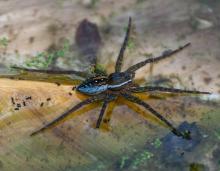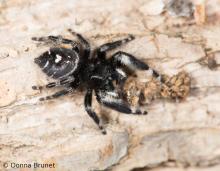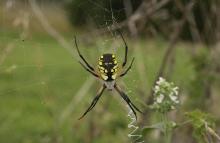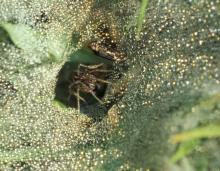Land Invertebrates
Media

Species Types
Scientific Name
Sphodros spp.
Description
Purseweb spiders build tubular webs attached to the bases of trees. Because these are easily overlooked, most people usually only see the males, which walk around in the open in early summer as they seek mates.
Media

Species Types
Scientific Name
Dolomedes triton
Description
The spotted fishing spider lives around ponds, slow-moving streams, swampy areas, and other damp places. It can run across the surface of water much like water striders and will dive for prey, including small tadpoles or aquatic insects.
Media

Species Types
Scientific Name
Loxosceles reclusa
Description
The brown recluse is a spider whose venomous bite may be medically significant to humans, though a bite is almost never fatal. Brown recluses are most commonly encountered in houses, where they occupy little-used drawers, closets, and other small hiding spaces.
Media

Species Types
Scientific Name
Nearly 250 species in North America north of Mexico
Description
A wolf spider doesn't spin webs to catch its prey — it runs it down like a wolf! Spiders in this family have long legs and are usually gray, brown, black, or tan with dark brown or black body markings (especially stripes).
Media

Species Types
Scientific Name
Dolomedes tenebrosus
Description
The dark fishing spider often evokes alarm because of its large size. This mottled black and brown spider is often misidentified. It is not always found near permanent water.
Media

Species Types
Scientific Name
Phidippus audax
Description
The bold jumper, or white-spotted jumping spider, is fuzzy, makes jerky movements, jumps surprisingly long distances, and doesn't build webs. It usually has a black body with white, orange, or reddish spots on the abdomen.
Media

Species Types
Scientific Name
Argiope aurantia
Description
The black-and-yellow garden spider is large but harmless. It sets up large, circular webs in gardens and grasslands. Lucky gardeners can host this remarkable pest exterminator all season long.
Media

Species Types
Scientific Name
Argiope trifasciata
Description
The banded, or white-backed garden spider is slightly smaller than the black-and-yellow garden spider and has a pointier hind end. The abdomen is patterned with many thin silver and yellow transverse lines and thicker black, spotty lines.
Media

Species Types
Scientific Name
Pisaurina spp.
Description
Nursery web spiders build silken tents in plants to protect their egg sacs, then stand guard until the hatchlings are ready to disperse. Large and velvety, nursery web spiders have long legs and variable color patterns.
Media

Species Types
Scientific Name
Agelenopsis spp.
Description
The funnel-shaped web of grass spiders is more often noticed than the spider itself. It is sheetlike, usually positioned horizontally, with a funnel leading downward to a shelter (a rock crevice or dense vegetation) where the spider hides, waiting for prey.
See Also



Media

Species Types
Scientific Name
Cisseps fulvicollis
Description
The yellow-collared scape moth is more often “orange-collared.” And whether you think it looks more like a firefly or a wasp, it’s still a moth!
Media

Species Types
Scientific Name
Nearly 150 species in North America north of Mexico
Description
Slim, delicate plume moths are instantly recognizable by their T-shaped silhouette, long legs, and muted shades of tan and brown. It can be hard to separate the various species.
Media

Species Types
Scientific Name
Pyrrharctia isabella
Description
Not many people know the adult Isabella tiger moth when they see one, but we’re all acquainted with its caterpillar, the woolly worm, or woolly bear.
About Land Invertebrates in Missouri
Invertebrates are animals without backbones, including earthworms, slugs, snails, and arthropods. Arthropods—invertebrates with “jointed legs” — are a group of invertebrates that includes crayfish, shrimp, millipedes, centipedes, mites, spiders, and insects. There may be as many as 10 million species of insects alive on earth today, and they probably constitute more than 90 percent all animal species.





















